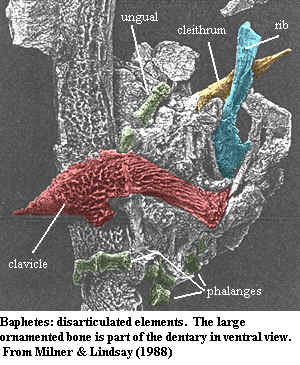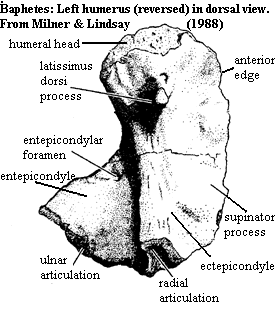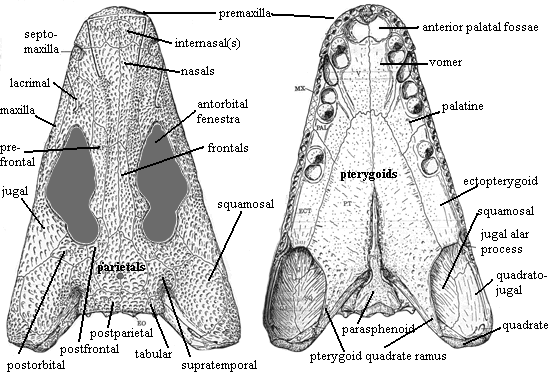
| Palaeos: |  |
Tetrapoda |
| The Vertebrates | Baphetidae (2) |
| Page Back | Unit Home | Unit Dendrogram | Unit References | Taxon Index | Page Next |
| Unit Back | Vertebrates Home | Vertebrate Dendrograms | Vertebrate References | Glossary | Unit Next |
|
Abbreviated Dendrogram
SARCOPTERYGII | TETRAPODA |--Acanthostega `--+--Ichthyostega `--+--Crassigyrinus |--Whatcheeriidae `--+--Colosteidae | `--Greererpeton `--+--Baphetidae | |--Loxomma | `--+--Baphetes | `--Megalocephalus |--Eucritta `--Tetrapoda* |--TEMNOSPONDYLI `--+--LEPOSPONDYLI `--REPTILIOMORPHA |
Contents
Overview |
 Baphetes: B.
planiceps Owen 1854. B. kirkbyi Watson 1929; B. bohemicus Fritsch
1889; B. lintonensis Beaumont 1977.
Baphetes: B.
planiceps Owen 1854. B. kirkbyi Watson 1929; B. bohemicus Fritsch
1889; B. lintonensis Beaumont 1977.
Range: Late Carboniferous (Bashkirian - Moscovian, Westphalian B & C) of Europe (Britain & the Czech Republic); Middle Pennsylvanian (Moscovian) of North America (Ohio).
Phylogeny: Baphetidae:: Megalocephalus + *.
Characters: broad, flat skull [C02]; skull up to 29 cm long with rounded snout [B77] [ML98]; lateral margins of premaxilla strongly ornamented [B77]; nares more anterior than in Loxomma; [B77]; antorbital vacuity slightly larger than orbit [B77]; postorbital with finger-like dorsomedial process [B77]; intertemporal present [B77]; skull table large & square, with long postparietals & tabulars [B77]; supratemporal extends around apex of otic notch [B77]; cheek long & deep [B77]; maxilla fairly short & does not meet quadratojugal so that jugal participates in skull margin [B77]; sclerotic plates present [ML98]; prominent suture between opisthotics on occiput in region of synotic tectum [B77] [3]; occiput and otic capsule otherwise as in other baphetids [B77]; parasphenoid with greater lateral expansion than other baphetids [B77]; palate: very similar to Loxomma [B77]; no anterior palatal vacuity [B77]; choanae ovoid & slightly elongate [B77]; dentition: numerous large teeth [C02]; structure as for Megalocephalus [B77]; highest premaxillary tooth count (10-11) [B77] [ML98]; marginal teeth lanceolate & slender with keeled crowns [ML98]; 34 marginal teeth on maxilla and usual tusk pairs [B77]; paired parasymphysial plate with fang pairs (i.e. one fang & a replacement pit on each plate) [ML98]; parasymphysial plates contact dentary & splenials, maybe coronoids [ML98]; possible ceratobranchial [ML98]; centra crescentic in anterior view, probable intercentra [ML98]; centra with ventral sagittal ridge [ML98]; dorsal ribs with flattened, triangular proximal head & thin distal expansion [ML98]; dorsal rib with little ventral curvature but some posterior curvature [ML98]; dorsal rib with longitudinal groove & posteriorly-directed uncinate process [ML98]; appendicular: clavicle ornamented, narrow & crescentic(?), with unique rectangular process on lateral margin [ML98] [4]; cleithrum long & strap-like with expanded, rounded head [ML98]; humerus L-shaped, with little torsion [ML98]; humerus with large deltopectoral crest (on anterior edge, right of lat. dors. process in image) [ML98]; humerus with prominent latissimus dorsi process [ML98]; humerus with robust, broad ectepicondylar ridge [ML98]; humerus entepicondyle quarter-circle [C98] contra ("triangular") [ML98]; humerus with entepicondylar foramen [ML98] [5]; humerus with distal and anterior margins incompletely ossified and not distally weight-bearing [ML98]; radius & ulna ~50% humerus length [ML98]; radius rectangular in cross-section [ML98]; ilium with both dorsal and posterior processes (primitive?); [ML98] [C98]; U-shaped supraacetabular crest [ML98]; ischium poorly ossified [ML98]; tibia stout, with strong cnemial crest & somewhat shorter than humerus [ML98]; tibia with sharp ridge on flexor (dorsal) surface [ML98]; fibula broad & same length as tibia [ML98]; other: ventral armor of elongate gastralia [C98]; but ventral armor of elongate, overlapping scales, with longitudinal ridge, but no ornament [ML98].
 Notes: [1] in especially lateral view,
the skull of Baphetes is
almost indistinguishable from Loxomma
save that the posterior extreme of the Baphetes jugal narrowly reaches
the ventral margin of the skull just anterior to the quadratojugal.
Dorsally, the skulls are identical in the pattern of dermal bones.
However, the Baphetes skull is clearly broader and more spatulate,
as well as longer, than the skull of Loxomma. Certain minor
differences are noted above. [2] Apparently the only baphetid where the
stapes is known. Stapes was 2 cm long and relatively stout -- plainly of
little use in hearing. [3] Beaumont argues that this demonstrates the
absence of a supraoccipital. In Megalocephalus there is no clear
suture, and a median flange of bone forms a slight ventrally-directed flange
which might be interpreted as a supraoccipital. Berman (2000) argues that
a supraoccipital is present. He posits that even a median suture does not
eliminate the possibility that a supraoccipital is present and fused with the
opisthotic. He points out that (a) paired supraoccipitals are known in one
specimen of Limnoscelis and (b) that the supraoccipital is normally fused
to other elements of the otic capsule. This feature has considerable importance
since it tends to move the baphetids into the anthracosaur area and away from
the temnospondyls. [4] In the image, note that the clavicle appears
to has been flattened during preservation. The portion to the right is the
ascending ramus which would have climbed the anterior margin of the
scapulocoracoid, with the ornamentation facing anterolaterally. The
ornamented surface of the portion to the left would have faced, perhaps,
lateroventrally, with the pointed end more or less posterior. Thus the
"upper" edge in the image would have faced medially and articulated
with the interclavicle. If we have this all right, the unique tab
structure on the "bottom" edge is probably a form of garden-variety pectoralis
process. Similar structures are known from the interclavicles or clavicles of,
e.g. Dimetrodon and lizards. [5] as Milner & Lindsay point
out, this is the only humeral foramen, in contrast to more basal
tetrapods.
Notes: [1] in especially lateral view,
the skull of Baphetes is
almost indistinguishable from Loxomma
save that the posterior extreme of the Baphetes jugal narrowly reaches
the ventral margin of the skull just anterior to the quadratojugal.
Dorsally, the skulls are identical in the pattern of dermal bones.
However, the Baphetes skull is clearly broader and more spatulate,
as well as longer, than the skull of Loxomma. Certain minor
differences are noted above. [2] Apparently the only baphetid where the
stapes is known. Stapes was 2 cm long and relatively stout -- plainly of
little use in hearing. [3] Beaumont argues that this demonstrates the
absence of a supraoccipital. In Megalocephalus there is no clear
suture, and a median flange of bone forms a slight ventrally-directed flange
which might be interpreted as a supraoccipital. Berman (2000) argues that
a supraoccipital is present. He posits that even a median suture does not
eliminate the possibility that a supraoccipital is present and fused with the
opisthotic. He points out that (a) paired supraoccipitals are known in one
specimen of Limnoscelis and (b) that the supraoccipital is normally fused
to other elements of the otic capsule. This feature has considerable importance
since it tends to move the baphetids into the anthracosaur area and away from
the temnospondyls. [4] In the image, note that the clavicle appears
to has been flattened during preservation. The portion to the right is the
ascending ramus which would have climbed the anterior margin of the
scapulocoracoid, with the ornamentation facing anterolaterally. The
ornamented surface of the portion to the left would have faced, perhaps,
lateroventrally, with the pointed end more or less posterior. Thus the
"upper" edge in the image would have faced medially and articulated
with the interclavicle. If we have this all right, the unique tab
structure on the "bottom" edge is probably a form of garden-variety pectoralis
process. Similar structures are known from the interclavicles or clavicles of,
e.g. Dimetrodon and lizards. [5] as Milner & Lindsay point
out, this is the only humeral foramen, in contrast to more basal
tetrapods.
Links: Air Breathers of the Coal Period; Annual Conference Abstracts 1999.
References: Beaumont (1977) [B77]; Berman (2000); Clack (1998) [C98]; Clack (2002) [C02]; Milner & Lindsay (1988) [ML98]. ATW020820.
 Megalocephalus:
M. pachycephalus Barkas 1873; M. lineolatus Cope 1877.
Megalocephalus:
M. pachycephalus Barkas 1873; M. lineolatus Cope 1877.
Range: Late Carboniferous (Bashkirian [Westphalian A] to Moscovian [Westphalian C]) of Europe (Britain & Ireland); also indeterminate middle Pennsylvanian (Late Carboniferous) of North America (Ohio).
Phylogeny: Baphetidae:: Baphetes + *.
Characters: Skull 35 cm [C02]; dermal skull: skull relatively narrow and pointed
[B77] [C02]; premaxilla long [B77]; lateral margins of premaxilla almost free of
ornament [B77]; premaxilla with nasolabial groove from nares to jaw margin
[B77]; premaxilla & maxilla suture narrowly with septomaxilla [B77];
septomaxilla ornamented & exposed on surface [B77]; nares more posteriorly
placed [B77]; internasals present and may be partially pierced by anterior
palatal foramina (for dentary tusks) [B77]; internasals may be paired or single
[B77]; lacrimal excluded from nares by nasals & maxilla [B77]; antorbital
vacuity twice length of orbit [B77]; nasals with central ridges [B77]; nasals
very long, with length 4x width [B77]; frontals depressed between antorbital
fenestrae, with prominent ridges on prefrontals continuing ridges of nasals
[B77]; skull table small, horizontal and firmly sutured to cheek [B77];
parietals extend between orbits, meeting prefrontals [B77]; pineal foramen
small, without boss [B77]; parietals broaden posteriorly [B77]; intertemporal absent [B77];
supratemporal expanded and forms anterior border of otic notch [B77];
postparietals small [B77]; orbits posteriorly placed at 2/3rds midline length
[B77]; prefrontals long & narrow, forming medial border of antorbital
fenestra [B77]; prefrontal does not meet jugal due to fenestration [B77];
sharp angle between skull table & cheek, which is almost vertical [B77];
postorbital vertical, meeting squamosal & jugal [B77]; jugal excluded from
skull margin  by maxilla-quadratojugal suture [B77]; jugal meets quadratojugal
[B77]; quadratojugal with concave articular surface for convex surface on
quadrate [B77]; quadrate medial surface forming palatoquadrate foramen as in
temnospondyls [B77]; quadrate not firmly sutured to skull roof [B77]; squamosal large, smoothly overlapping quadrate ramus of
pterygoid inside otic notch [B77]; squamosal also overlaps supratemporal in otic
notch [B77]; paroccipital process articulates with tabular and supratemporal of
skull table [B77]; large posttemporal fenestrae [B77]; massive concave
occipital condyle with contributions from exoccipitals and basioccipital [B77];
exoccipital with massive, bifurcated dorsolateral column [B77]; nerve XII exits
between branches of exoccipital column [B77]; braincase: otic capsule with
two short, stout columnar processes articulating with exoccipital columns [B77];
parasphenoid sheaths anterior of basioccipital, but lateral edges ended in free
rim [B77] (early homologue of crista
muscularis?); V-shaped
depressions on ventral face of parasphenoid for attachment of neck muscles
[B77]; parasphenoid floors otic capsule and wraps base of basisphenoid at and
posterior to basipterygoid process [B77]; parasphenoid with internal carotid foramina near
base of cultriform process [B77]; epipterygoid with extensive
quadrate ramus following pterygoid quadrate ramus, which sutures extensively
with the quadrate [B77]; epipterygoid columella
poorly ossified [B77]; epipterygoid with anterior extension fused to palatal
ramus of pterygoid [B77]; palate: premaxillae with triangular buttresses meeting &
interlocking on midline behind symphysis [B77]; anterior fenestrae for parasymphysial tusks [B77]; premaxillae without palatine
ramus [B77] vomers thickened where they meet the anterior fenestrae and support
vomerine tusks [B77]; choanae elongate, laterally
placed at posterior limit of premaxilla [B77]; palatines and
ectopterygoids with dorsal processes meeting lacrimals & jugals
(respectively) to wall antorbital fenestrae [B77]; ectopterygoids weakly attached to maxilla, as separated by groove for dentary
teeth and, posteriorly, by jugal alar process [B77]; pterygoids notched to form conical
recess at base of quadrate ramus (articulation with braincase) [B77]; pterygoids meet for anterior
1/3 of length [B77]; jugal with very strong
alar process projecting into adductor fossa [B77]; adductor fossae very large [B77];
pterygoid quadrate ramus
almost vertically oriented, extending well below level of cheek bones [B77];
mandible: extensive roughened areas near symphysis for ligaments
binding jaw rami [B77]; parasymphysial plate with small teeth ("psym
fang" in image) [AC98]; dentary with little medial exposure (covered by
coronoids) [B77]; 4 main medial foramina penetrating splenial, postsplenial
& angular [B77]; coronoid process absent [B77]; splenial, postsplenial &
angular wrap around jaw to suture with prearticular [AC98]; Meckelian fossa
enters space between posterior coronoid and dentary as extension of adductor
fossa [B77]; posterior coronoid with only slight, weak contact with surangular
[B77]; large, deep adductor fossa (attachment of adductor muscles) walled
laterally by surangular, anteriorly by posterior coronoid, & medially by
prearticular [B77]; no retroarticular process [B77]; articulation terminal and
above level of tooth row [B77]; articular with two articulating surfaces: main ,
horizontal, transverse area and, more medially, an anteromedially-directed area
(could have allowed jaw to expand) [B77]; dentition: teeth larger than in Loxomma [C02]; premaxilla with
8-9 teeth [B77]; maxilla with 36 [B77]; dentary ~34 teeth including three
tusk-like pairs [B77]; no size peak, but teeth gradually smaller posteriorly
[B77]; tusk pairs and denticles on all roof bones except pterygoids
[B77]; parasymphysial dentary tusks fit into anterior palatal fenestra [B77];
all teeth round at base, becoming laterally compressed with anterior and
posterior cutting edges [B77]; pterygoids and parasphenoid with shagreen of small denticles [B77];
coronoids and prearticular with shagreen of small denticles [B77] contra
[AC98]; lower teeth only on dentary [B77]; postcranial:
interclavicle rhomboidal [B77]; dermal bone ornamentation
marked, but with smaller individual ornaments [B77] growth zones (elongated
ornament) along frontal prefrontal & nasal, as well as along lower margin of
cheek and squamosal.
by maxilla-quadratojugal suture [B77]; jugal meets quadratojugal
[B77]; quadratojugal with concave articular surface for convex surface on
quadrate [B77]; quadrate medial surface forming palatoquadrate foramen as in
temnospondyls [B77]; quadrate not firmly sutured to skull roof [B77]; squamosal large, smoothly overlapping quadrate ramus of
pterygoid inside otic notch [B77]; squamosal also overlaps supratemporal in otic
notch [B77]; paroccipital process articulates with tabular and supratemporal of
skull table [B77]; large posttemporal fenestrae [B77]; massive concave
occipital condyle with contributions from exoccipitals and basioccipital [B77];
exoccipital with massive, bifurcated dorsolateral column [B77]; nerve XII exits
between branches of exoccipital column [B77]; braincase: otic capsule with
two short, stout columnar processes articulating with exoccipital columns [B77];
parasphenoid sheaths anterior of basioccipital, but lateral edges ended in free
rim [B77] (early homologue of crista
muscularis?); V-shaped
depressions on ventral face of parasphenoid for attachment of neck muscles
[B77]; parasphenoid floors otic capsule and wraps base of basisphenoid at and
posterior to basipterygoid process [B77]; parasphenoid with internal carotid foramina near
base of cultriform process [B77]; epipterygoid with extensive
quadrate ramus following pterygoid quadrate ramus, which sutures extensively
with the quadrate [B77]; epipterygoid columella
poorly ossified [B77]; epipterygoid with anterior extension fused to palatal
ramus of pterygoid [B77]; palate: premaxillae with triangular buttresses meeting &
interlocking on midline behind symphysis [B77]; anterior fenestrae for parasymphysial tusks [B77]; premaxillae without palatine
ramus [B77] vomers thickened where they meet the anterior fenestrae and support
vomerine tusks [B77]; choanae elongate, laterally
placed at posterior limit of premaxilla [B77]; palatines and
ectopterygoids with dorsal processes meeting lacrimals & jugals
(respectively) to wall antorbital fenestrae [B77]; ectopterygoids weakly attached to maxilla, as separated by groove for dentary
teeth and, posteriorly, by jugal alar process [B77]; pterygoids notched to form conical
recess at base of quadrate ramus (articulation with braincase) [B77]; pterygoids meet for anterior
1/3 of length [B77]; jugal with very strong
alar process projecting into adductor fossa [B77]; adductor fossae very large [B77];
pterygoid quadrate ramus
almost vertically oriented, extending well below level of cheek bones [B77];
mandible: extensive roughened areas near symphysis for ligaments
binding jaw rami [B77]; parasymphysial plate with small teeth ("psym
fang" in image) [AC98]; dentary with little medial exposure (covered by
coronoids) [B77]; 4 main medial foramina penetrating splenial, postsplenial
& angular [B77]; coronoid process absent [B77]; splenial, postsplenial &
angular wrap around jaw to suture with prearticular [AC98]; Meckelian fossa
enters space between posterior coronoid and dentary as extension of adductor
fossa [B77]; posterior coronoid with only slight, weak contact with surangular
[B77]; large, deep adductor fossa (attachment of adductor muscles) walled
laterally by surangular, anteriorly by posterior coronoid, & medially by
prearticular [B77]; no retroarticular process [B77]; articulation terminal and
above level of tooth row [B77]; articular with two articulating surfaces: main ,
horizontal, transverse area and, more medially, an anteromedially-directed area
(could have allowed jaw to expand) [B77]; dentition: teeth larger than in Loxomma [C02]; premaxilla with
8-9 teeth [B77]; maxilla with 36 [B77]; dentary ~34 teeth including three
tusk-like pairs [B77]; no size peak, but teeth gradually smaller posteriorly
[B77]; tusk pairs and denticles on all roof bones except pterygoids
[B77]; parasymphysial dentary tusks fit into anterior palatal fenestra [B77];
all teeth round at base, becoming laterally compressed with anterior and
posterior cutting edges [B77]; pterygoids and parasphenoid with shagreen of small denticles [B77];
coronoids and prearticular with shagreen of small denticles [B77] contra
[AC98]; lower teeth only on dentary [B77]; postcranial:
interclavicle rhomboidal [B77]; dermal bone ornamentation
marked, but with smaller individual ornaments [B77] growth zones (elongated
ornament) along frontal prefrontal & nasal, as well as along lower margin of
cheek and squamosal.
|
|
|
| Megalocephalus: reconstruction of lower jaw in lateral and medial views. From Beaumont (1977) (lateral view) and Ahlberg & Clack (1998) (medial view). | Megalocephalus: reconstruction of lower jaw in dorsal view. From Beaumont (1977). |
Note: [1] The history of the name "Megalocephalus" is a dark and gothic tale of great complexity. The story involves almost every conceivable pitfall of biological nomenclature, including, inter alia, published mis-spellings, misidentifications, chimeras, garbage taxa, preoccupied names, and -- finally -- the riddle of a holotype destroyed by fire after initial publication, but before complete description. [2] Megalocephalus is the most completely known baphetid skull.
Links: Loxommatidae (Baphetidae); Dinosaurclass.Com (Chinese).
References: Ahlberg & Clack (1998) [AC98]; Beaumont (1977) [B77]; Clack (2002) [C02]. ATW020820.
| Page Back | Unit Home | Page Top | Page Next |
checked ATW040813